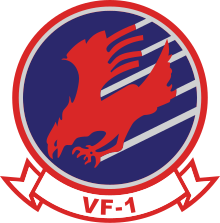
The Northrop Grumman E-2 Hawkeye is an American all-weather, carrier-capable tactical airborne early warning (AEW) aircraft. This twin-turboprop aircraft was designed and developed during the late 1950s and early 1960s by the Grumman Aircraft Company for the United States Navy as a replacement for the earlier, piston-engined E-1 Tracer, which was rapidly becoming obsolete. The aircraft's performance has been upgraded with the E-2B and E-2C versions, where most of the changes were made to the radar and radio communications due to advances in electronic integrated circuits and other electronics. The fourth major version of the Hawkeye is the E-2D, which first flew in 2007. The E-2 was the first aircraft designed specifically for AEW, as opposed to a modification of an existing airframe, such as the Boeing E-3 Sentry. Variants of the Hawkeye have been in continuous production since 1960, giving it the longest production run of any carrier-based aircraft.

Marine Corps Air Station Miramar is a United States Marine Corps installation that is home to the 3rd Marine Aircraft Wing, which is the aviation element of the 1st Marine Expeditionary Force. It is located in Miramar, a community of San Diego, California, about 14 miles (23 km) north of downtown San Diego.
A naval flight officer (NFO) is a commissioned officer in the United States Navy or United States Marine Corps who specializes in airborne weapons and sensor systems. NFOs are not pilots (naval aviators), but they may perform many "co-pilot" or "mission specialist" functions, depending on the type of aircraft. Until 1966, their duties were performed by both commissioned officer and senior enlisted naval aviation observers (NAO).
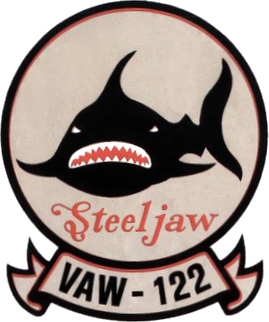
Carrier Airborne Early Warning Squadron 122 (VAW-122) was an aviation unit of the United States Navy in service from 1 September 1967 to 31 March 1996. Originally nicknamed the "Hummer Gators" and later as "Steeljaws" was a U.S. Atlantic Coast Carrier Airborne Early Warning Squadron stationed at NAS Norfolk. During its 30 years of existence, the squadron was deployed around the world and saw action from Vietnam to Desert Storm, conducting operations from the Arctic to the tropics.

Carrier Airborne Early Warning Squadron 121 (VAW-121), also known as the "Bluetails", is an Airborne Early Warning (AEW) and Command and control (C2) squadron of the United States Navy, operating the E-2D Hawkeye. Established in 1967, the squadron is based at NAS Norfolk. It is currently assigned to Carrier Air Wing 7 and deploys aboard the aircraft carrier USS George H.W. Bush; VAW-121 is undergoing a scheduled maintenance period.

A carrier air wing is an operational naval aviation organization composed of several aircraft squadrons and detachments of various types of fixed-wing and rotary-wing aircraft. Organized, equipped and trained to conduct modern US Navy carrier air operations while embarked aboard aircraft carriers, the various squadrons in an air wing have different but complementary missions, and provide most of the striking power and electronic warfare capabilities of a carrier battle group (CVBG). While the CVBG term is still used by other nations, the CVBG in US parlance is now known as a carrier strike group (CSG).

Airborne Command and Control Squadron 123 (VAW-123) is based at Naval Station Norfolk, flying the E-2C Hawkeye. They are attached to Carrier Air Wing Three (CVW-3) while deployed aboard USS Dwight D. Eisenhower. The squadron nickname is the Screwtops.

Airborne Command & Control Squadron 116 (VAW-116) is a US Navy Command and Control Squadron that deploys aboard USS Nimitz as part of Carrier Air Wing Seventeen, flying the E-2C Hawkeye 2000 aircraft. VAW-116 is stationed at Naval Base Ventura County under the cognizance of Commander, Airborne Command Control and Logistics Wing (COMACCLOGWING). The current commanding officer is Commander Phillip J. Sheridan.

Airborne Command & Control Squadron 117 (VAW-117) is an airborne early warning (AEW) and command and control (C2) squadron. Nicknamed "The Wallbangers,” it flies the E-2D Hawkeye, the only carrier-capable command and control aircraft. The squadron is based in NAS Point Mugu and deploys as part of Carrier Air Wing 9 (CVW-9) on board USS Abraham Lincoln.
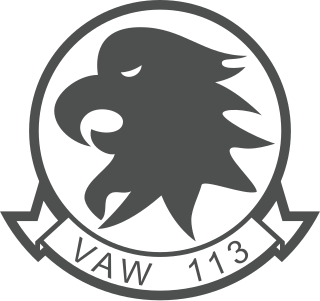
Airborne Command & Control Squadron 113 (VAW-113), known as "Black Eagles", was established on 20 April 1967 flying the E-2A Hawkeye.

Airborne Command and Control Squadron 115 (VAW-115), also known as the "Liberty Bells", is a United States Navy airborne early warning and control squadron that flies the E-2D Advanced Hawkeye.
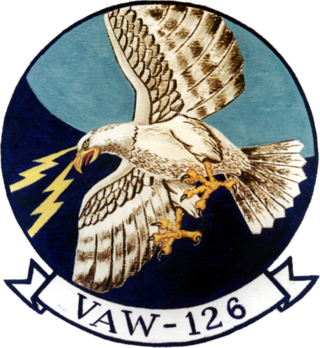
Carrier Airborne Early Warning Squadron 126 (VAW-126), nicknamed the "Seahawks", is a carrier airborne early warning squadron of the United States Navy. The squadron is based at NS Norfolk, equipped with five E-2D Hawkeye aircraft.

Carrier Airborne Early Warning Squadron 112 (VAW-112) is an inactive United States Navy squadron. It was nicknamed the "Golden Hawks". VAW-112 flew the E-2C Hawkeye out of NAS Point Mugu and last deployed in 2013 as part of Carrier Air Wing 9 (CVW-9) on board USS John C. Stennis.

Airborne Command & Control Squadron 120 (VAW-120) is a United States Navy Fleet Replacement Squadron responsible for training crews on the E-2 Hawkeye and the C-2A(R) Greyhound.

Airborne Command & Control Squadron 124 (VAW-124) "Bear Aces" is a United States Navy airborne early warning and control squadron based at Naval Air Station Norfolk, Norfolk, Virginia. It flies the Northrop Grumman E-2D Hawkeye and is currently attached to Carrier Air Wing 8 (CVW-8).

Carrier Airborne Early Warning Squadron 78 (VAW-78), nicknamed the "Fighting Escargots" or "Slugs" was a reserve Carrier Airborne Early Warning Squadron of the U.S. Navy. It was established on 1 July 1970 as part of a major reorganization of the Naval Air Reserve and deactivated on 31 March 2005.

Carrier Airborne Early Warning Squadron 114 (VAW-114), nicknamed the "Hormel Hawgs". It was established on 20 April 1967, based out of NAS North Island, at which time it was already flying missions over the Tonkin Gulf in Vietnam. The squadron was disestablished on 31 March 1995 while attached to NAS Miramar.
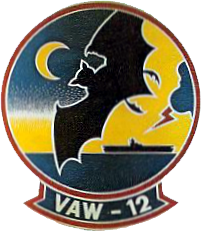
Carrier Airborne Early Warning Squadron 12 (VAW-12), nicknamed the "Bats", was a U.S. Navy Carrier Airborne Early Warning Squadron. The squadron was disestablished on 1 April 1967.

Fighter Squadron 1 (VF-1) was a fighter squadron of the United States Navy. Originally established on 14 October 1972 it was disestablished on 30 September 1993. It was the fifth US Navy squadron to be designated VF-1. Known as the "Wolfpack" the squadron saw combat during the Vietnam War and Operation Desert Storm. The squadron was de-activated and its personnel reassigned in 1993 when its carrier, USS Ranger, was decommissioned.


